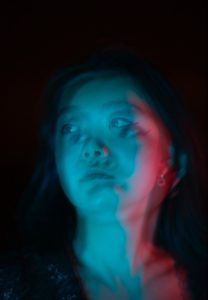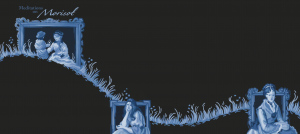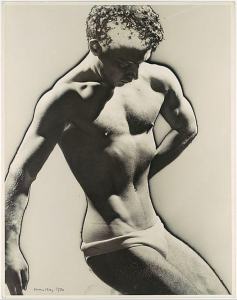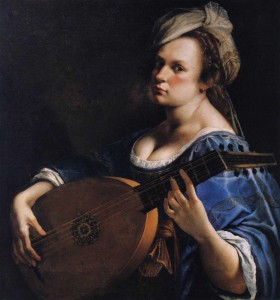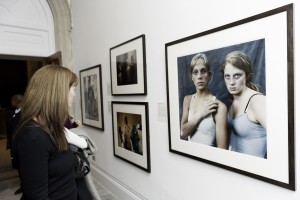
ART-ificial Intelligence: The Curious Case of Edmond De Belamy
by Olivia Hicks | March 1, 2019
In late October 2018, Christie’s, a fine art auction house, sold a portrait, a print on canvas. It shows an austere gentleman dressed in black – the eponymous Edmond de Belamy. It is one of a series of portraits of the Belamy family and by far the best known, though they all share the same style. Blurry and distorted, with a soft and surreal face that is in no way human, the Edmond de Belamy portrait looks as if it is constantly in motion, caught between two moments of time. The portrait looks unusual, and it is: the Belamy family does not exist, has never existed, and every single portrait in the collection was generated by “artificial intelligence”, in the form of Generative Adversarial Networks (GAN). It is strikingly beautiful, otherworldly, strange, and not painted by a human hand. Though the initial estimates for the price of the painting were under $10,000, the portrait finally sold to an anonymous bidder for a staggering $432,000, a price unheard of for AI-artwork.

What exactly are Generative Adversarial Networks? Well, simply put, it is an algorithm in which a dataset is fed into a series of networks – in the Edmond de Belamy case, it was a collection of 15,000 pre-twentieth century portraits. A “generative network” creates a new image based off the dataset, and a “discriminative network” tries to distinguish the new images from the original dataset. Eventually, the algorithm produces an image which it cannot discriminate from the original dataset. To put it crudely, the Edmond de Belamy portrait is what AI thinks a human face looks like. For many people, AI’s ability to create art provokes unease and even fear, some of it at least centred around the loss of what was, until now, a strictly human skill. Thus, the fact that Edmond de Belamy represents technology’s best estimation of a human face, yet is so far from anything we would recognise as such, may be of some comfort to those who are struck with fear at the idea of machine art; at least, in this aspect, we are far ahead.
The Belamy family is the brainchild of Paris art collective Obvious, headed by Hugo Caselles-Dupré, Pierre Fautrel, and Gauthier Vernier. However, they are not the first to use GAN to create art. Rutgers University even have their own Art and Artificial Intelligence Lab. Many coders and artists have employed the technique, and usually share their work on twitter and Instagram, though many are now exhibiting their work in established galleries. One particularly striking artist is Helena Sarin, who feeds her own artwork into GAN to create her works – hazy, dreamlike abstract collages of landscapes and florals. Coders often share open-source code that they have created, working together as the genre develops – it is not a particularly populous community, but a dedicated one. In fact, AI-generated art need not be visual at all; AI has been used to create music, such as with the Luxembourgish AIVA (Artificial Intelligence Visual Artist) which has composed classical and symphonic music that sounds remarkably authentic and might even be harder to distinguish from human-generated art than GAN’s attempts to make recreations of the human face.
Far from being the first to employ GAN to create art, the Obvious art collective is the result of a cumulative discipline. In fact, Obvious garnered some controversy after the sale of the Edmond de Belamy portrait after it emerged that they had used a great deal of open-source code from 19-year-old Robbie Barrat, without any public credit. This demonstrates problems that can occur when new forms of artwork and technologies which contribute to the creation of artwork suddenly appear on the mainstream stage. As of yet, there is no accepted infrastructure for determining intellectual property, authorship, and ownership for artwork that must be created with many constituent parts, if human beings are to be credited at all.
If this sort of art has been created before, albeit not in a hugely public manner, why did the Edmond de Belamy painting sell for such a high price? Marketing played a significant part; the way AI was used to create the painting might not be especially innovative, but the presentation of the role of AI in the painting certainly is. The painting is signed not with a human name, but with an impressive-looking algorithm in cursive script. The name itself is a pun on its GAN origins – Belamy sounds a lot like the French bel ami, a play on the name of GAN creator Ian Goodfellow. Christie’s described the work as “not the product of a human mind”, and packaged the sale as “the first piece of AI-art to come to auction.” It was a curious move on Christie’s part, as they chose to divert attention away from the impressive human minds that have created complicated technology capable of producing artwork and instead drew the narrative towards an imagined human vacuum. It is worth noting, however, that what sets the Edmond de Belamy portrait apart from prior GAN-generated images – along with the sort of polish and luck necessary in the fine art world – are these very human elements of both technology and marketing.
Art critic Jonathan Jones refuses to acknowledge Edmond de Belamy – or anything created by artificial intelligence – as art at all. He writes that “computers would need to replicate human consciousness before they could replicate the funny thing humans do called ‘art’. Art is a way in which human consciousness expresses itself, and is equally true of the earliest cave art, Rembrandt’s portraits and Duchamp’s urinal. And that is what is missing from Portrait of Edmond Belamy. Artis a way humans communicate ideas, perceptions and feelings to each other.”
We decided long ago that only humans can create art. We must have done, because we do not consider geodes or the aurora borealis or barrier reefs to be art, even though the time and money we spend looking at them shows that we do find them beautiful. We do seem, on some level, to yearn for that purpose, the desire to create beauty rather than the accident of it, before we bestow that noble title “art”. In deciding what is art, we are not content to stop at art itself. We insist on going beyond the frame and ask for reassurance that there was indeed a determined, purposeful, and enlightened creative process that resulted in the thing that gets the term. Yet we organised all of this in our minds before we had any idea that we could one day create machines capable of creating beauty. When beauty was either part of the natural world or human-made, we could at least argue that beauty and humanity were necessary, if not sufficient, conditions for art. Now, however, there is a third source for things that we find beautiful. These machines exist with the sole purpose of creating things that look like the things which we created in order to be beautiful, and it is hard to see why exactly this is not art.
Jones argues that “art is a way humans communicate ideas, perceptions and feelings to each other.” Well, perhaps – but do these ideas, perceptions, and feelings come in to being when the art is created, or when it is received? If art is indeed how humans communicate to each other, then that implies that reception is what really matters. AI-created art can definitely arouse ideas, perceptions, and feelings in its viewers: the eerie beauty of the de Belamy, the wonder at what humans and machines are able to do, the gasping fear of a world we are slowly creating in which we ourselves are obsolete. The painting then becomes a powerful tool for communicating these ideas with those around us, which is the way all art serves to communicate – through the dialogue of interpretation, which is rarely with the artist themselves. Additionally, GAN are striving to replicate art that has historically generated these thoughts and ideas – as it stands, only human emotion and the human desire for understanding can be drawn upon as the machine works towards its goal of creating an image which it believes will meet some sort of human standard of aesthetic satisfaction, whether or not the machine itself will ever be able to comprehend the same standard.
There is the argument that there is not the necessary creativity required for the title of art in AI pieces because the algorithm is simply looking at the way things have previously and satisfactorily been presented, and mimicking them – it is looking to reproduce art and artistic portrayals, not to draw inspiration from the world around it and express this with emotion and flair. However, human artists do this too. Often conventions are drawn from art more than they are from close observation of reality, best demonstrated in art historian E.H. Gombrich’s example of the galloping horse; before the invention of the camera, he notes, the galloping horse was always painted with all four legs outstretched in the air (he gives an example of Gericault’s “Horse-racing at Epsom”). However, when photography was advanced enough to capture motion, photographer Eadweard Muybridge realised that horses do not run like this at all; their legs are drawn inwards successively, rarely with all four off the ground at one time. When artists began to portray horse galloping in this new, more authentic manner, this did not satisfy those who viewed the art. They saw it as wrong, because it did not look like the art they were accustomed to. We, in the present time, look at these pre-photography paintings and struggle to take these flying horses seriously at all. Gombrich sums up the problem quite nicely; “we have a curious habit of thinking that nature must always look like the pictures we are accustomed to.” Basically, GAN are doing what artists have always done; looking out of the corner of their eye to their neighbour’s work, rather than closely analysing the scene before them.
Quite aside from the question of whether the product of GAN is art, it is also possible to see the whole process of the aesthetically minded GAN as a piece of conceptual or performance art. Indeed, the process is fascinating. It’s very easy to get lost in an internet hole of videos of GAN at work – watching the various images slip and slide across the screens, faces and landscapes appearing and disappearing in some sort of malleable, two dimensional, liquid clay. It calls into question our relationship with technology, our relationship with the future, and the very fact that humans have geared this technology to create art in the first place – that however futuristic we seem to become, there is something within us that longs to create things that exist to be looked at, and serve no other direct function; the inherent human desire for art that isn’t going anywhere as long as we are not. If we value ourselves as consumers of art and not just as creators of it, then it doesn’t make sense to fear AI-generated art. But perhaps we fear the loss of ourselves as creators of the art that we consume. The reassurance to this fear rests in the reminder of where GAN, and all artificial intelligence, come from, and a reminder of the relationship between humanity and technology.
Humans created art, humans created machines, and now machines create art. But ultimately, everything about this artificial intelligence-created art is heavily human. People make the machines and algorithms, people made and chose the images that are fed into them. In fact, there seems so much human choice surrounding this way of creating art that the artificial intelligence involved is perhaps better seen as a medium, rather than an artist. Artists who use GAN as a medium can select images after running the algorithm many times, can choose what they use as the initial datasets, and can edit and manipulate final results to their own tastes and desires. Some, like Helena Sarin, will use artwork that they have created by hand and will feed this through the medium of GAN to create new works, which are still her creations. In this way, to replace the human artist with the machine itself seems to run against the way we have assigned authorship and ownership of artwork until this moment. After all, photography exhibitions are not credited to the make or type of camera, but to the human behind the lens. If AI art really takes off – and the high price of the Edmond de Belamy suggests that some investors are seriously considering it – then it will be another medium through which we express that most human of endeavours, which, for now, remains ours alone. ∎
Writing by Olivia Hicks. Original Artwork by Issy Davies.
